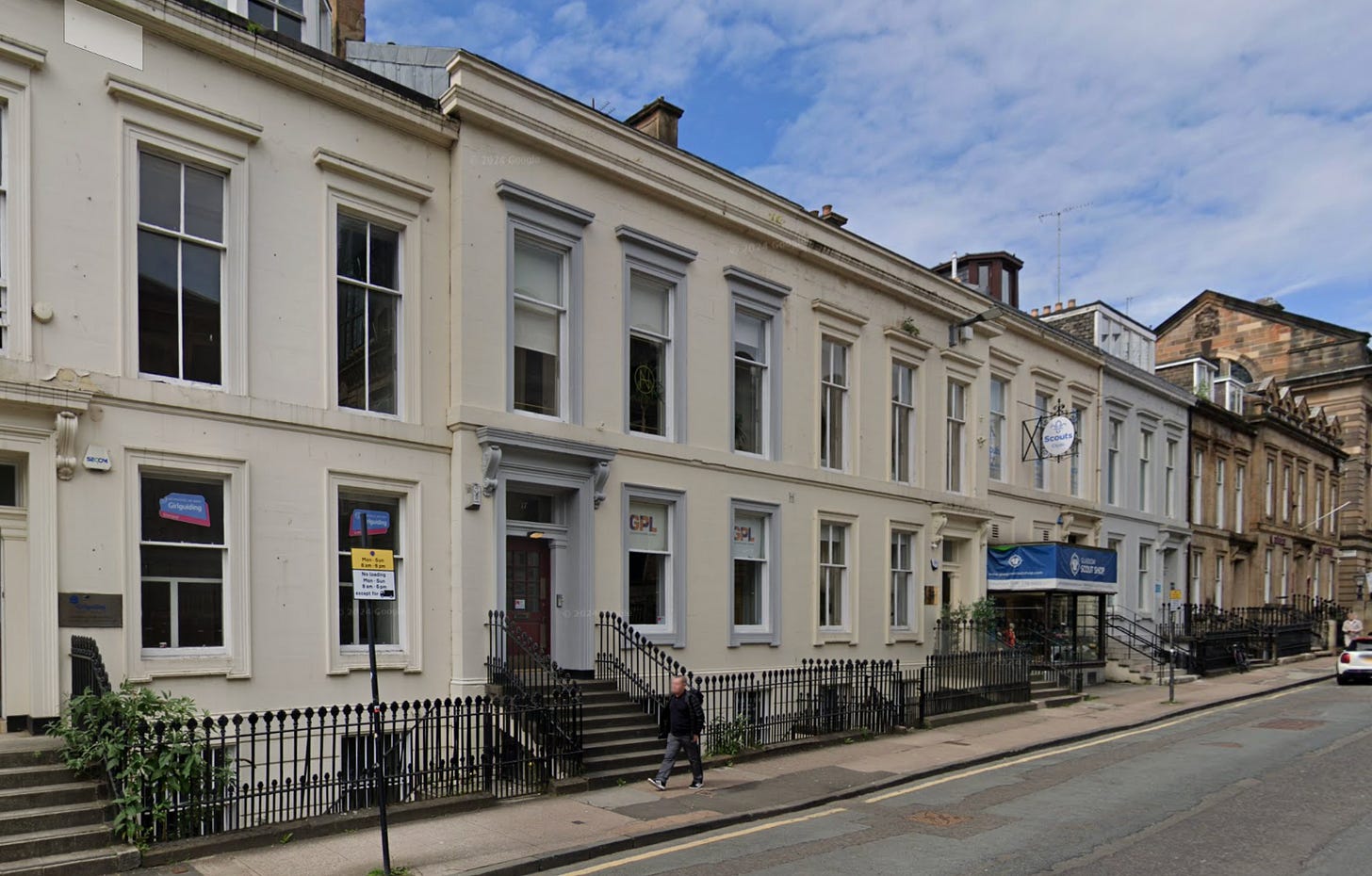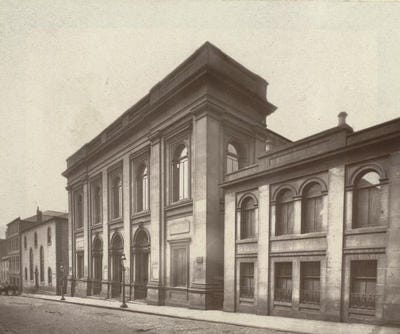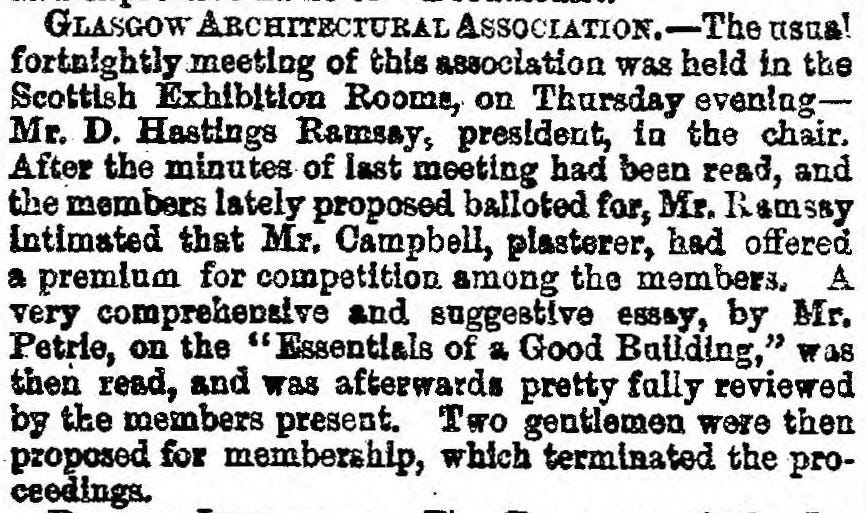Thomson's architectural acquaintances
Looking at lesser architects working in Glasgow in Thomson's time
The 1875 Glasgow Post Office Directory, published in the middle of the year, includes a professional entry for the Glasgow Institute of Architects, whose objects are described as:
The advancement of the art and science of architecture.
The consideration and discussion of all subjects and questions connected, directly or indirectly, with the profession of architects, and the concentrated expression of opinion upon the same.
The elevation of the attainments, the promotion of the efficiency, and the protection of the interests of the architects of Glasgow.
The establishment of a uniform rate of charge by the members for professional business in cases where no special agreement as to remuneration is made by the parties.
The doing of all such other things as are incidental or conducive to the attainment of the above objects.
The office-bearers (listed as elected in 1874) were John Baird (Alexander Thomson’s brother-in-law and former partner) as President, Campbell Douglas as Vice-President, James Sellars as Treasurer and James Salmon as Auditor, with W McLean (not an architect) as Secretary. There were three Councillors surnamed ‘Thomson’ but unrelated: Alexander, David and James.
With 44 members in 1875, the GIA was not representative of all the practising architects in the city, and two of its members were based outside Glasgow: J Murdoch, of 48 New Market Street, Ayr, and John James Stevenson, who had decamped to London. The Directory, however, lists 99 group and individual architectural practices.
Many of these became well-known architects, and most worked in close proximity, within a few city blocks of one another: 19 in St Vincent Street (and one more in St Vincent Place), 17 in West George Street (with A & G Thomson round the corner at 122 Wellington Street), 15 in West Regent Street, and seven each in Bath Street and Renfield Street. There were outliers: DH Ramsay at 4 Eaglesham Street, Henry McGenn at 228 Govan Road, and James Smith at 141 Great Hamilton Street, Alex Louttit at 88-90 Houston Street, while John Smellie’s address was Clydeview, Whiteinch.
Haig & Low
At 122 Wellington Street, there was also the Dundee-born David Paton Low (1827-1910), but he was a tenant in a partnership with John Haig rather than part of the A & G Thomson practice. In 1858, Low won the Soane Medallion (according to newspaper reports of the time, he had been in the running for it previously ‘but for an informal circumstance’ that prevented him from being awarded the prize)1. In his acceptance speech, Low commented that ‘his success on this occasion would only be a stepping-stone to further exertions’, and when Haig & Low’s partnership began in 1859, it immediately achieved prominence, coming third place in the Wallace Monument competition that year, and drawing up plans for Elmbank Place (possibly the terrace seen below in Elmbank Street).
The practice was unsuccessful in other competition entries, however, save for the East Campbell Street United Presbyterian Church of 1862-64 (below), extant, but converted in 1932 into the East Campbell Street Lodging House Mission (the practice won the Kirkcudbright Public Rooms competition in 1860, but the project never went ahead). He also entered the first competition for the Glasgow Municipal Buildings, but not, it seems, the second.
Within a year, however, the partnership had been dissolved, with Haig and Low afterwards operating from separate offices in Hope Street.
Low did well enough that around 1882, he reportedly built Fairfield House for himself in Ayr, now a much-extended hotel (below).
Around 1895, he built his last known work, a music warehouse at 520 Sauchiehall Street (below, the one with the bust of Beethoven on its Renfrew Street frontage), which became a succession of cinemas and clubs and is currently slated for conversion, together with the neighbouring gap site, into student accommodation (retaining the frontage, however).
The mysterious DH Ramsay
The online Dictionary of Scottish Architects has no information about DH Ramsay, but he must have had some local reputation since, in 1862, he was President of the Glasgow Architectural Association2.
Douglas Hastings Ramsay was born about 1834, the youngest of three sons and four daughters of an army pensioner who had seen service with the Duke of Wellington in the Peninsular War and possibly also at Waterloo. He married in Edinburgh two years after the end of the Napoleonic Wars, having retired as a sergeant-major, and his oldest children were born there.
Of Douglas’s two elder brothers, the eldest became a mercantile clerk and the next an apparently successful measurer (judging by his address at Mosspark House, Pollokshields). Of his sisters, the fate of the eldest is unknown (she may have died young); one remained at home as housekeeper to her father and died unmarried; one married and bore two children, but her husband may have died within a few years of her marriage since she spent many of the later years living with her father and sister; another married Peter McCormick, a pattern designer (although in what industry isn’t known).
Even at the age of 17, D H Ramsay (as appears in the Directory) was giving his occupation as ‘Architect’ in the 1851 Census (although this may be a recording error for ‘Architectural Apprentice’ or similar). He had graduated to ‘Architect's Assistant’ by the time of the 1861 Census, but it is not known to whom he was attached.
His professional career may have been short-circuited by a spell in Duke Street Prison, to which he was committed in 1864. The cause and duration of his sentence isn’t known. He had been released by January 1865 when his first wife died, aged 28, with the cause given as ‘Probably excessive drinking’.
At this point, Harvey had three children, all below ten years of age. By mid-1866 he had moved to Newcastle-upon-Tyne, where he lived long enough to join the electoral register and, in 1874, to marry for the second time. He returned to Glasgow, where his last two children were born in 1875 and 1877 and resumed listing himself as an architect, but presumably working as an assistant or draughtsman. He died in July 1882 from apoplexy at Stranraer, possibly while on holiday.
Henry McGenn, would-be architect?
The online Dictionary of Scottish Architects describes Henry McGenn as an ‘architect, surveyor, and property agent’, but apart from his various addresses, not much more is known.
McGenn was the son of a Stirlingshire-born handloom weaver who had settled in Kilwinning, Ayrshire, in his twenties and remained there. Henry was the second son of four, and there was one older sister: the eldest brother remained in Kilwinning as a silk weaver with his sister as, presumably, housekeeper. Of the other two brothers, one became an iron moulder, moved to Partick and died there at the age of 31 from typhus, leaving a widow and four young children; the youngest became a schoolteacher in Port Glasgow.
Henry himself was working as a home-based silk weaver at the age of 14, but must have left for Glasgow by his early twenties since he married there in 1860. Two years later, he was probably the ‘H. McGenn’ who delivered an address to the Partick Young Men’s Mutual Improvement Association annual soiree on ‘The land we live in’3, but after that his connections are essentially based around Govan and Ibrox. Where and how he came to train as an architect isn’t known, nor whether he was responsible for any of the tenements he subsequently advertised for sale or to let, or for anything else.
It is quite likely that McGenn was aware of Thomson’s work, since in March 1869 he was advertising ‘To Let, at Princess Buildings, Carmichael Street, Govan (within 20 minutes’ walk of town), Houses of 3 Rooms and Kitchen’4. As this range on the eastern side of Carmichael Street was being completed and let out, work on a distinctly Thomsonian tenement was under way on the opposite side of the street, at Carmichael Street’s junction with Govan Road, and on a separate but similar block at the junction further south with Vicarfield Road. These were sufficiently completed for them to be advertised to let in February 18715.

While letting out Princess Buildings, McGenn was also seeking tenants for ‘Superior Houses of 2 and 3 Rooms and Kitchen at Whitefield Road’ (he was living with his family at No. 16 at the time)6.
Socially, the Partick Young Men’s Mutual Improvement Association had been replaced by the Govan Bowling Club, of which McGenn became a committee member7.
He continued to sell houses and flats in Govan and Ibrox, and this accounts for his only known appearances in the Glasgow newspapers of the time. While he was content to call himself a ‘House Factor & Property Agent’ in the 1871 Census, he thereafter referred to himself as an Architect, so he may have been responsible for some of the tenements he later sold, such as ‘Three Substantial tenements in best part of West Govan’, or ‘A Very Superior Corner Tenement, consisting of Houses of Three and Four Apartments’. None of this is recorded, however.
What is recorded is that he was sentenced to a period of imprisonment at Duke Street in 1891 (where he is referred to as a ‘Builder’), but the reason is not given. He may have come across William Ramsay, son of D H Ramsay, who spent time in Duke Street the same year (following on from his father a quarter-century earlier).
From McGenn’s marriage came two sons and four daughters; the eldest son died aged ten years; the rest of the family lived together at the western end of Sauchiehall Street following their father’s death from apoplexy in 1899, aged 62, by which time Henry McGenn was living in Shettleston. He and his children are all buried in Craigton Cemetery.
North British Daily Mail, 28 Apr 1858
Glasgow Herald, 29 Nov 1862
North British Daily Mail, 8 Mar 1862
Glasgow Herald, 11 Mar 1869
See the Substack article ‘A tenement with more interesting neighbours?’
Glasgow Evening Citizen, 11 Mar 1869
North British Daily Mail, 16 Apr 1870








